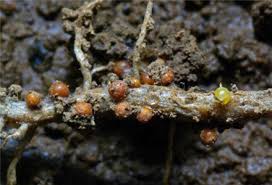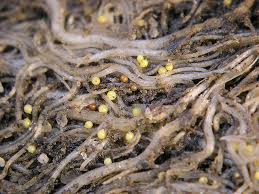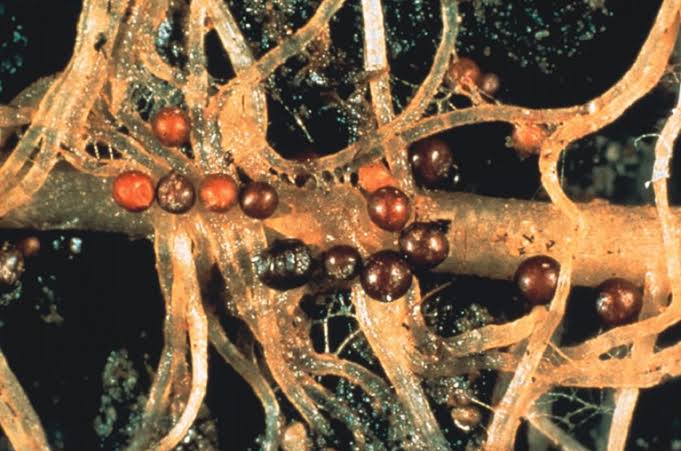Cyst nematodes, scientifically known as Heterodera, are microscopic roundworms that can have a significant impact on plants. These tiny creatures may seem harmless, but their presence in the soil can lead to detrimental consequences for various crops.
These nematodes earn their name from the cyst-like structures that females form during their life cycle. These cysts protect and house the eggs, ensuring the continuation of the nematode population. Once formed, these cysts become a silent threat to agriculture, lying in wait for unsuspecting plants.
As cyst nematodes infest the soil, they target the roots of plants, causing damage that often goes unnoticed until it’s too late. The nematodes invade the root tissues, extracting essential nutrients and hindering the plant’s ability to absorb water. This parasitic relationship weakens the plant, making it susceptible to diseases and reducing its overall yield.
Farmers face the challenge of managing cyst nematode infestations to safeguard their crops. Traditional methods involve crop rotation and the use of resistant plant varieties. Crop rotation disrupts the nematode’s life cycle, preventing them from establishing a continuous presence in the soil. Resistant plant varieties, on the other hand, offer a natural defense against these tiny invaders.
Despite these efforts, cyst nematodes remain resilient, adapting to various environmental conditions. Researchers continually explore new strategies to control and mitigate the impact of these microscopic pests on agriculture.
Understanding the life cycle of cyst nematodes is crucial in developing effective control measures. The nematode life cycle consists of several stages, starting with the eggs within the cysts. Once hatched, the nematodes progress through juvenile stages, seeking out host plants to invade. The cycle repeats as they mature, forming new cysts and perpetuating the infestation.
However, cyst nematodes pose a hidden threat to agriculture, affecting the health and productivity of plants. While scientists and farmers employ various strategies to manage these microscopic pests, the constant evolution of nematode populations challenges our ability to control them effectively. Ongoing research remains vital to develop sustainable solutions that safeguard crops and ensure the resilience of agriculture against these tiny but impactful adversaries.
Read Also: How to Farm and Care for Chum Salmon Fish (Oncorhynchus keta)
Plants Affected by Cyst Nematodes (Heterodera)

Cyst nematodes can impact a wide range of plants, affecting various crops and agricultural vegetation. These microscopic pests have a knack for targeting the roots of plants, causing damage that can lead to reduced yields and compromised plant health. Some of the notable plants affected by cyst nematodes include:
1. Soybeans: Cyst nematodes are known to be a significant concern for soybean crops. They infiltrate the soybean roots, hindering the plant’s ability to absorb nutrients and water, ultimately affecting soybean yield.
2. Wheat: Cyst nematodes pose a threat to wheat crops, where they can lead to stunted growth and a decline in overall productivity. The damage inflicted on wheat roots can have long-lasting effects on the quality and quantity of the harvest.
3. Corn: Although corn is not as commonly affected as some other crops, certain species of cyst nematodes can impact corn plants. Infestations may result in decreased root health and nutrient absorption.
4. Potatoes: Cyst nematodes can harm potato crops by infecting the roots, leading to reduced tuber formation and overall yield. Managing nematode populations is crucial for maintaining healthy potato crops.
5. Tomatoes: Tomato plants are susceptible to cyst nematode infestations, causing damage to the root system and affecting the plant’s growth and fruit production. Controlling nematode populations is essential for preserving tomato harvests.
6. Carrots: Cyst nematodes can target carrot roots, affecting their development and quality. The damage inflicted on carrot crops may lead to deformities and a decline in marketable produce.
7. Sugar Beets: Cyst nematodes can impact sugar beet crops, affecting the roots and reducing the sugar content in the beets. This can result in economic losses for sugar beet farmers.
8. Sorghum: Certain species of cyst nematodes can pose a threat to sorghum crops. The damage to sorghum roots may impact the plant’s ability to take up water and nutrients, affecting its overall growth.
These examples highlight the diverse range of crops that can be affected by cyst nematodes. Effective management strategies, such as crop rotation and the use of resistant plant varieties, are essential for mitigating the impact of these microscopic pests on agricultural productivity.
Damages Caused by Cyst Nematodes

Cyst nematodes inflict various damages on plants, primarily targeting the roots and disrupting the normal functioning of affected crops. The consequences of cyst nematode infestations can be severe, leading to significant economic losses for farmers. Here are some of the damages caused by cyst nematodes:
1. Stunted Growth: One of the primary effects of cyst nematode infestations is stunted growth in plants. The nematodes invade the roots, impairing the plant’s ability to take up water and nutrients. This hampers overall plant development, resulting in smaller and weaker crops.
2. Reduced Yield: Cyst nematodes can significantly reduce crop yields by limiting the plant’s capacity to produce fruits, vegetables, or grains. The damage inflicted on the roots directly impacts the reproductive capabilities of the plant, leading to diminished harvests.
3. Deformed Roots: The nematodes cause deformities in the roots of affected plants. As they feed on root tissues, cyst nematodes create galls or swellings, altering the normal structure of the roots. This deformation further contributes to the compromised health of the plant.
4. Nutrient Deficiency: By feeding on root tissues, cyst nematodes disrupt the plant’s ability to absorb essential nutrients from the soil. This can result in nutrient deficiencies, affecting various physiological processes within the plant and leading to visible symptoms such as yellowing of leaves and poor overall vigor.
5. Increased Susceptibility to Diseases: Cyst nematode-infested plants become more vulnerable to other diseases and infections. The weakened state of the plant makes it an easy target for secondary pathogens, amplifying the overall impact on crop health.
6. Root Rot: The damage caused by cyst nematodes creates entry points for soil-borne pathogens, increasing the risk of root rot. This further exacerbates the decline in root health and compromises the plant’s ability to anchor itself in the soil.
7. Water Stress: As cyst nematodes disrupt the root system, affected plants struggle to absorb an adequate amount of water from the soil. This can lead to water stress, causing wilting and further contributing to the overall decline in plant health.
8. Economic Losses: The combined effects of stunted growth, reduced yields, and increased susceptibility to diseases result in significant economic losses for farmers. Cyst nematode infestations impact the profitability of agricultural enterprises and may require costly management interventions.
In addition, cyst nematodes inflict a range of damages on plants, affecting their growth, yield, and overall health. Farmers and researchers continually seek effective strategies to mitigate these damages and sustain the productivity of agricultural crops.
Read Also: How to Farm and Care for Antarctic krill (Euphausia superba)
Control and Preventive Measures

Controlling and preventing cyst nematode infestations is crucial for maintaining healthy crops and minimizing economic losses in agriculture. Several strategies can be employed to manage these microscopic pests effectively. Here are some key control and preventive measures:
1. Crop Rotation: Implementing a diverse crop rotation system disrupts the nematode life cycle. By alternating between nematode-susceptible and nematode-resistant crops, farmers can reduce nematode populations in the soil and mitigate the risk of infestation.
2. Resistant Varieties: Planting crop varieties that have resistance to specific cyst nematode species is an effective strategy. Resistant plants can withstand nematode infestations, reducing the impact on crop yield and overall plant health.
3. Nematicides: Chemical nematicides can be applied to the soil to control cyst nematode populations. However, the use of nematicides should be approached with caution due to potential environmental impacts and the development of resistance in nematode populations.
4. Cover Crops: Planting cover crops that are non-hosts or poor hosts for cyst nematodes can help suppress nematode populations. These cover crops create unfavorable conditions for nematode survival and reproduction.
5. Soil Solarization: This method involves covering the soil with transparent plastic sheets during the hot summer months. The solar heat trapped under the plastic helps reduce nematode populations in the upper soil layers.
6. Biofumigation: Certain plants, known as biofumigant crops, release natural compounds that have nematode-suppressing properties. Incorporating these crops into the rotation can contribute to nematode management.
7. Sanitation Practices: Practicing good sanitation in the field, such as removing and destroying crop residues, can help reduce the carryover of nematode cysts from one season to the next. Proper equipment cleaning and soil management also play a role in preventing nematode spread.
8. Biological Control: Beneficial organisms, such as predatory nematodes and fungi, can be introduced into the soil to naturally control cyst nematode populations. This method relies on the natural predators of nematodes to keep their numbers in check.
9. Monitoring and Early Detection: Regularly monitoring fields for signs of nematode infestation, such as stunted growth and root deformities, enables early detection. Early intervention can prevent further nematode buildup and reduce the impact on crops.
10. Integrated Pest Management (IPM): Implementing an integrated approach that combines various control methods is often the most effective way to manage cyst nematodes sustainably. This approach considers ecological, biological, cultural, and chemical control measures in a coordinated manner.
By employing a combination of these control and preventive measures, farmers can better manage cyst nematode infestations and promote the health and productivity of their crops in a sustainable manner.
Frequently Asked Questions (FAQs) About Cyst Nematodes (Heterodera)
1. Q: What are cyst nematodes?
A: Cyst nematodes are microscopic roundworms that can adversely affect plants by infesting their roots. They are named for the cyst-like structures formed by female nematodes to protect and house their eggs.
2. Q: How do cyst nematodes damage plants?
A: Cyst nematodes damage plants by invading their root systems, causing stunted growth, deformed roots, and reduced nutrient absorption. This can lead to a decline in overall plant health and crop yield.
3. Q: Which crops are commonly affected by cyst nematodes?
A: Cyst nematodes can affect a variety of crops, including soybeans, wheat, corn, potatoes, tomatoes, carrots, sugar beets, and sorghum, among others.
4. Q: How can farmers control cyst nematode infestations?
A: Farmers can control cyst nematodes through practices such as crop rotation, planting resistant varieties, using nematicides (with caution), incorporating cover crops, practicing soil solarization, and implementing biological control measures.
5. Q: Are there natural predators for cyst nematodes?
A: Yes, certain beneficial organisms like predatory nematodes and fungi act as natural predators, helping to control cyst nematode populations in the soil.
6. Q: What is soil solarization, and how does it help control cyst nematodes?
A: Soil solarization involves covering the soil with transparent plastic sheets during hot months to trap solar heat. This process helps reduce cyst nematode populations in the upper soil layers by creating unfavorable conditions for their survival.
7. Q: Can cyst nematodes be completely eradicated from the soil?
A: Complete eradication of cyst nematodes is challenging, but effective management strategies can significantly reduce their populations and minimize the impact on crops.
8. Q: How do resistant plant varieties help in nematode control?
A: Resistant plant varieties have genetic traits that make them less susceptible to cyst nematodes. Planting these varieties can help mitigate the impact of nematode infestations on crop yield and plant health.
9. Q: What are the signs of cyst nematode infestation in crops?
A: Signs of cyst nematode infestation include stunted growth, deformed roots, reduced yield, and increased susceptibility to diseases. Regular monitoring helps in early detection.
10. Q: Are there environmentally friendly methods to control cyst nematodes?
A: Yes, environmentally friendly methods include biological control, crop rotation, and the use of cover crops. These methods aim to manage nematode populations while minimizing environmental impact.
Read Also: Exploring The Tips and Benefits Of Fitness Classes
